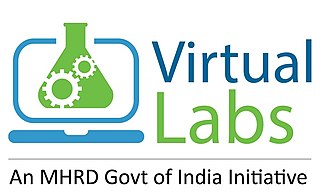
Telerobotics is the area of robotics concerned with the control of semi-autonomous robots from a distance, chiefly using television, wireless networks or tethered connections. It is a combination of two major subfields, which are teleoperation and telepresence.

A computer lab is a space where computer services are provided to a defined community. These are typically public libraries and academic institutions. Generally, users must follow a certain user policy to retain access to the computers. This usually consists of rules such as no illegal activity during use or attempts to circumvent any security or content-control software while using the computers.
Moodle is a free and open-source learning management system written in PHP and distributed under the GNU General Public License. Moodle is used for blended learning, distance education, flipped classroom and other online learning projects in schools, universities, workplaces and other sectors.

Laboratory Virtual Instrument Engineering Workbench (LabVIEW) is a system-design platform and development environment for a visual programming language developed by National Instruments.
Neuroergonomics is the application of neuroscience to ergonomics. Traditional ergonomic studies rely predominantly on psychological explanations to address human factors issues such as: work performance, operational safety, and workplace-related risks. Neuroergonomics, in contrast, addresses the biological substrates of ergonomic concerns, with an emphasis on the role of the human nervous system.

Colin Simpson is a Canadian entrepreneur, software developer, and the author of seven textbooks, including the bestseller Principles of Electronics. With over 500,000 of his textbooks in print, Dr. Simpson is considered as an expert in the teaching of electronics and electronics simulation technology. He has won numerous awards including the Award of Excellence from the Association of Canadian Community Colleges (ACCC), the TVOntario Lifelong Learning Challenge Award, and the Codie award from the Software Publishers Association. Simpson holds two patents in electronics laboratory simulation and control systems technology, and is recognized as an authority on distance education and the integration of laboratory simulation software. He has been interviewed by the CBC, PBS, CTV, TVOntario, The Globe and Mail, Toronto Star, Chicago Tribune, and has lectured at universities around the world. Simpson has a Ph.D. in Electrical Engineering from the University of Hawaii and a Doctorate of Letters from Nipissing University.
OpenLearn is an educational website. It is the UK's Open University's contribution to the open educational resources (OER) project and the home of free, open learning from The Open University. The original project was part-funded by the William and Flora Hewlett Foundation. OpenLearn is a member of the OpenCourseWare Consortium (OCWC).

nanoHUB.org is a science and engineering gateway comprising community-contributed resources and geared toward education, professional networking, and interactive simulation tools for nanotechnology. Funded by the United States National Science Foundation (NSF), it is a product of the Network for Computational Nanotechnology (NCN). NCN supports research efforts in nanoelectronics; nanomaterials; nanoelectromechanical systems (NEMS); nanofluidics; nanomedicine, nanobiology; and nanophotonics.
Web-based simulation (WBS) is the invocation of computer simulation services over the World Wide Web, specifically through a web browser. Increasingly, the web is being looked upon as an environment for providing modeling and simulation applications, and as such, is an emerging area of investigation within the simulation community.
An instructional simulation, also called an educational simulation, is a simulation of some type of reality but which also includes instructional elements that help a learner explore, navigate or obtain more information about that system or environment that cannot generally be acquired from mere experimentation. Instructional simulations are typically goal oriented and focus learners on specific facts, concepts, or applications of the system or environment. Today, most universities make lifelong learning possible by offering a virtual learning environment (VLE). Not only can users access learning at different times in their lives, but they can also immerse themselves in learning without physically moving to a learning facility, or interact face to face with an instructor in real time. Such VLEs vary widely in interactivity and scope. For example, there are virtual classes, virtual labs, virtual programs, virtual library, virtual training, etc. Researchers have classified VLE in 4 types:
Virtual worlds are playing an increasingly important role in education, especially in language learning. By March 2007 it was estimated that over 200 universities or academic institutions were involved in Second Life. Joe Miller, Linden Lab Vice President of Platform and Technology Development, claimed in 2009 that "Language learning is the most common education-based activity in Second Life". Many mainstream language institutes and private language schools are now using 3D virtual environments to support language learning.

A Virtual Learning Environment (VLE) is a system specifically designed to facilitate the management of educational courses by teachers for their students. It predominantly relies on computer hardware and software, enabling distance learning. In North America, this concept is commonly denoted as a "Learning Management System" (LMS).
A remote experiment is a real experiment with real laboratory instruments and equipment that can be controlled by a computer through the internet. One or more remote experiments are accessible in remote laboratory.

Virtual Labs is a project initiated by the Ministry of Education, Government of India, under the National Mission on Education through Information and Communication Technology. The project aims to provide remote access to Laboratories in various disciplines of Science and Engineering for students at all levels from undergraduate to research.

Astronaut training describes the complex process of preparing astronauts in regions around the world for their space missions before, during and after the flight, which includes medical tests, physical training, extra-vehicular activity (EVA) training, procedure training, rehabilitation process, as well as training on experiments they will accomplish during their stay in space.
A battle lab or battle laboratory is an organization dedicated to studying changes in the military.
Virtual reality (VR) is a computer application which allows users to experience immersive, three dimensional visual and audio simulations. According to Pinho (2004), virtual reality is characterized by immersion in the 3D world, interaction with virtual objects, and involvement in exploring the virtual environment. The feasibility of the virtual reality in education has been debated due to several obstacles such as affordability of VR software and hardware. The psychological effects of virtual reality are also a negative consideration. However, recent technological progress has made VR more viable and promise new learning models and styles for students. These facets of virtual reality have found applications within the primary education sphere in enhancing student learning, increasing engagement, and creating new opportunities for addressing learning preferences.
E-engineering, is a concept that combines distance learning and remote laboratories.
Virtual reality is the creation of a three-dimensional, interactive environment. With this technology, users are able to move through this developed simulation, as if it is real.
A cloud laboratory is a heavily automated, centralized research laboratory where scientists can run an experiment from a computer in a remote location. Cloud laboratories offer the execution of life science research experiments under a cloud computing service model, allowing researchers to retain full control over experimental design. Users create experimental protocols through a high-level API and the experiment is executed in the cloud laboratory, with no need for the user to be involved.







